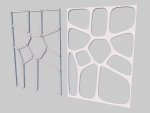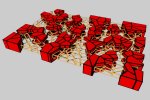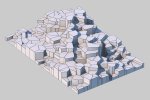Joel
0
How to convert coplanar splines to coplanar polygons?
Hiroto's Voronoi Plane.js script divides a plane into a random Voronoi pattern of polygons. His PolygonToSpline.js script converts polygon edges to splines. What I need is similar but different: to import a 2D Inkscape SVG or PDF file into C3D and convert the linear splines to a plane with polygons. I have a little experience importing Illustrator files into C3D to use with the Extrusion Creator Tool, like the "Illustrator to Cheetah 3D" example in Cheetah 3D Help where compound paths are extruded with beveled covers to make a 3D logo.
I am using the Open Source Inkscape program because it has an extension to generate a geometrically precise Voronoi object from a user-made pattern of dots/points. The same extension generates Delaunay patterns, the triangular pattern from which the Voronoi pattern is calculated.
Where I am stuck: I can import a combined/composite SVG or PDF into C3D, but I can only make an extrusion or sweep. I have tried to come up with a work-around starting with an extrusion. Neither a combined/composite path or uncombined group of individual linear splines have made anything useful.
Is there a simple and efficient way to convert the coplanar splines to a 3D plane with points/edges/polygons?
Hiroto's Voronoi Plane.js script divides a plane into a random Voronoi pattern of polygons. His PolygonToSpline.js script converts polygon edges to splines. What I need is similar but different: to import a 2D Inkscape SVG or PDF file into C3D and convert the linear splines to a plane with polygons. I have a little experience importing Illustrator files into C3D to use with the Extrusion Creator Tool, like the "Illustrator to Cheetah 3D" example in Cheetah 3D Help where compound paths are extruded with beveled covers to make a 3D logo.
I am using the Open Source Inkscape program because it has an extension to generate a geometrically precise Voronoi object from a user-made pattern of dots/points. The same extension generates Delaunay patterns, the triangular pattern from which the Voronoi pattern is calculated.
Where I am stuck: I can import a combined/composite SVG or PDF into C3D, but I can only make an extrusion or sweep. I have tried to come up with a work-around starting with an extrusion. Neither a combined/composite path or uncombined group of individual linear splines have made anything useful.
Is there a simple and efficient way to convert the coplanar splines to a 3D plane with points/edges/polygons?










